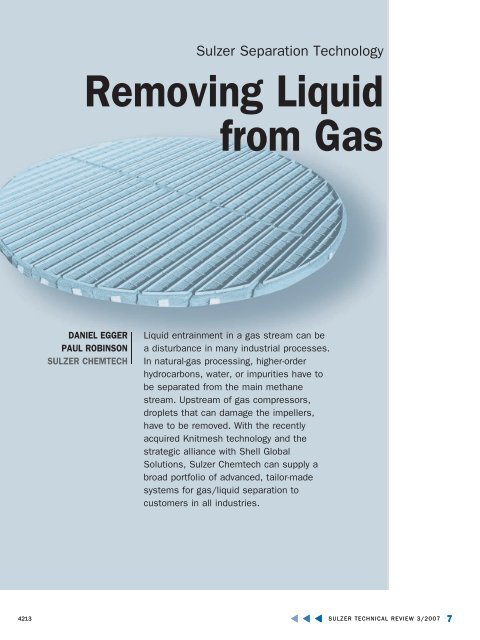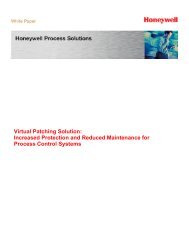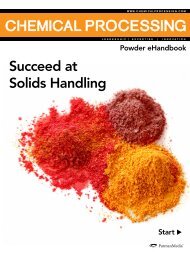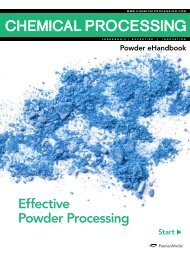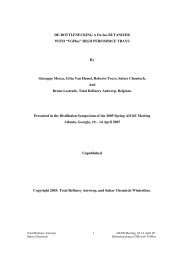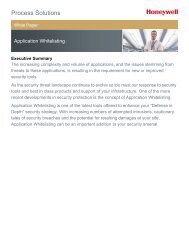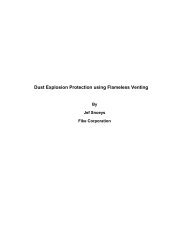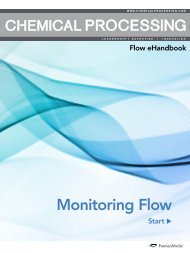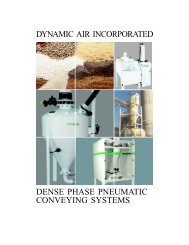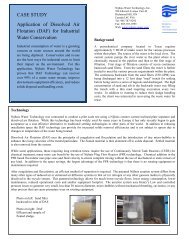Removing Liquid from Gas - Sulzer
Removing Liquid from Gas - Sulzer
Removing Liquid from Gas - Sulzer
- No tags were found...
Create successful ePaper yourself
Turn your PDF publications into a flip-book with our unique Google optimized e-Paper software.
<strong>Sulzer</strong> Separation Technology<strong>Removing</strong> <strong>Liquid</strong><strong>from</strong> <strong>Gas</strong>DANIEL EGGERPAUL ROBINSONSULZER CHEMTECH<strong>Liquid</strong> entrainment in a gas stream can bea disturbance in many industrial processes.In natural-gas processing, higher-orderhydrocarbons, water, or impurities have tobe separated <strong>from</strong> the main methanestream. Upstream of gas compressors,droplets that can damage the impellers,have to be removed. With the recentlyacquired Knitmesh technology and thestrategic alliance with Shell GlobalSolutions, <strong>Sulzer</strong> Chemtech can supply abroad portfolio of advanced, tailor-madesystems for gas/liquid separation tocustomers in all industries.4213SULZER TECHNICAL REVIEW 3/2007 7
© BP p.l.c1 In many industrial processes, liquidhas to be separated <strong>from</strong> process gas,e.g., in the dehydration of liquefiednatural gas (LNG). <strong>Sulzer</strong> Chemtech offersa wide range of mist eliminators.<strong>Liquid</strong> entrainment in a gasstream can be caused byeither dynamic processes such ascontact between gas and liquidphases in a mass transfer operation,or thermal processes such ascondensation. For example, dropletscan result <strong>from</strong> bursting bubbles,e.g., in distillation columns.When saturated gases are cooled,the vapor condenses and the gascan become locally supersaturated,causing droplet formation.This type of condensation mist canoccur in heat exchange processes,during a sudden release of pressure,or by mixing hot and cold gasstreams.<strong>Removing</strong> <strong>Liquid</strong> EntrainmentIf the gas is traveling too fast forthe liquid droplets to settle out undergravity, they become suspended,or entrained. In most cases, theentrainment must be removed toprevent process disturbance or environmentalcontamination. Installationof mist eliminators is aneffective solution to liquid entrainmentproblems in process applicationsincluding scrubbing, absorption,stripping, or distillationcolumns, evaporators, as well asdesalination, refrigeration, and gasdehydration plants (Fig. 1).Equipment for all CasesSeveral types of mist eliminatorsexist for the separation of entrainedliquid . In order to choosethe appropriate equipment, it isnecessary to consider the differentmechanisms used to capture dropletson a wire or other surfaces(Fig. 2). Industrial gas/liquid separatorsrely upon diffusional deposition,direct or inertial interception,or a combination of thesemechanisms (Fig. 3).The droplet size distribution determinesthe suitable mechanism foreach application. One example isgas drying using glycol contactors,where droplet sizes often lie in therange of 5–25 µm. Here, direct andinertial interception are the mostappropriate mechanisms and separationis best achieved by impingementof droplets in high-performancemist eliminators. Conversely,this type is often inappropriatefor separation of acid mistsin sulfuric-acid plants, where submicrondroplets are formed anddiffusional deposition must beconsidered.Finding the Right SizeFor equipment based on director inertial interception or a combinationof both, gas stream velocityaffects all 3 principles involved inseparation (impingement, coalescence,and drainage). A relation betweengas/vapor density, liquiddensity, and gas velocity, expressedas K-value, governs the requiredarea for such mist eliminators.For diffusional interception to occur,superficial gas velocities haveto be low, typically they are onetenthof that for inertial interception.On the other hand, pressuredrop across candle filters is up to10 times higher than that acrossvane pack and wire-mesh misteliminators and usually determinestheir sizing. This constraintoften leads to large surface areasand consequently large vesselsizes.DropletsInertial interceptionFlow streamlinesGravityFiberDiffusionDirect interception0607 2510112 Diffusional deposition, inertial ordirect interception and gravity are the4 possible mechanisms for dropletcollection. Gravitational deposition isuneconomical for industrial processes.Demisting DevicesBaffles, louvers, and vane packsrely upon inertial interception ofdroplets on the separator surface,usually banks of plates or bladesaround which the gas must pass.Because of their mass, largedroplets deviate <strong>from</strong> the gas flowand are captured and separated onthe plates. Vane packs, like the<strong>Sulzer</strong> Mellachevron, are moresophisticated and specifically designedto handle high-volume gasflow and reduce fouling. They areideal for duties with heavy liquidloads or where the capacity of conventionalwire mesh mist eliminatorsis exceeded.<strong>Sulzer</strong> Chemtech now offers the<strong>Sulzer</strong> Knitmesh range, knitted8SULZER TECHNICAL REVIEW 3/2007
Collection MechanismInertial interceptionInertial and direct interceptionDirect interception and diffusional deposition3 Depending on droplet size and gas velocity in the process, industrial misteliminators rely upon a combination of physical mechanisms for droplet collection.wire-mesh mist eliminators thatare a low cost, highly versatile, andefficient method of removing liquidentrainment <strong>from</strong> gas streams.In typical vertical-flow applications,separation is achieved byimpingement on and capture bythe filaments where the dropletscoalesce and drain towards thelower face of the mist eliminator,before disengaging and drainingaway <strong>from</strong> the pad against theflow of incoming gas.InletPreconditioner0607 250516<strong>Gas</strong>-PhaseOutletMellachevronMist Eliminator<strong>Liquid</strong>Downcomer<strong>Liquid</strong>-PhaseOutlet4 Combined system of preconditionerand <strong>Sulzer</strong> Mellachevron vane pack.Tailor-Made KnitmeshMist EliminatorsIndustry standard designs areideal for routine applications. Formore demanding applications,<strong>Sulzer</strong> Chemtech uses sophisticatedmodeling techniques to tailorthe wire-mesh mist eliminatorstructure to specific process requirements.This moves the designof wire mist eliminators away<strong>from</strong> conventional industry rulesand provides a more precisemethod of predicting performanceover a range of possible inlet con-Mist Eliminatorsbaffles, louvers, vane packs,axial-flow cyclonesknitted wire meshcandle filtersditions, so that the effects ofchanging drop size distributionand liquid holdup can be considered.Combined SystemsIncreasing gas capacities and higherperformance requirements arechallenging the capabilities of conventionalmist eliminator equipment.To solve this, <strong>Sulzer</strong> Chemtechoffers combined systemswhich employ the benefits of individualtypes of equipment and improveoverall performance. For example,Knitmesh mist eliminatorscan be used in combination with<strong>Sulzer</strong> Mellachevron vane packs(Fig. 4) or with Shell Swirltubes axial-flowcyclones (see STR 2/2005,p. 11) to produce very high separationefficiencies at high gas loadings.When using the Knitmesh misteliminator as a preconditioner forthe Mellachevron or Swirltubes, itis operated above its normal floodingpoint and consequently liquid0 10 20 30 40 50is stripped away <strong>from</strong> the downstreamsurface. However, the liquiddispersion re-entrained <strong>from</strong>the preconditioner has a largermean diameter and is suitable forsubsequent separation by secondary,high-capacity equipment suchas vane packs (Fig. 5). At low gasvelocities, where vane packs tendto be ineffective, preconditionersbehave as conventional wire meshmist eliminators.<strong>Sulzer</strong> Chemtech supports customerswith its engineering expertiseallowing proper selectionof equipment and its design philosophy.The division’s experts arealso able to provide assistancewith complex product separationprocesses, construction and engineeringdrawings, as wells as onsiteconsultations during the constructionand installation phase.Contact<strong>Sulzer</strong> Chemtech AGDaniel Egger<strong>Sulzer</strong>-Allee 488404 WinterthurSwitzerlandPhone +41 52 262 50 08Fax +41 56 262 00 64daniel.egger@sulzer.com5 When used as a preconditioner, <strong>Sulzer</strong> Knitmesh mist eliminators movethe droplet size to larger diameters. A subsequent <strong>Sulzer</strong> Mellachevron vanepack can then separate the larger droplets very efficiently.FrequencyInletOutletDrop size (µm)0607 251010 0607 251201SULZER TECHNICAL REVIEW 3/2007 9


